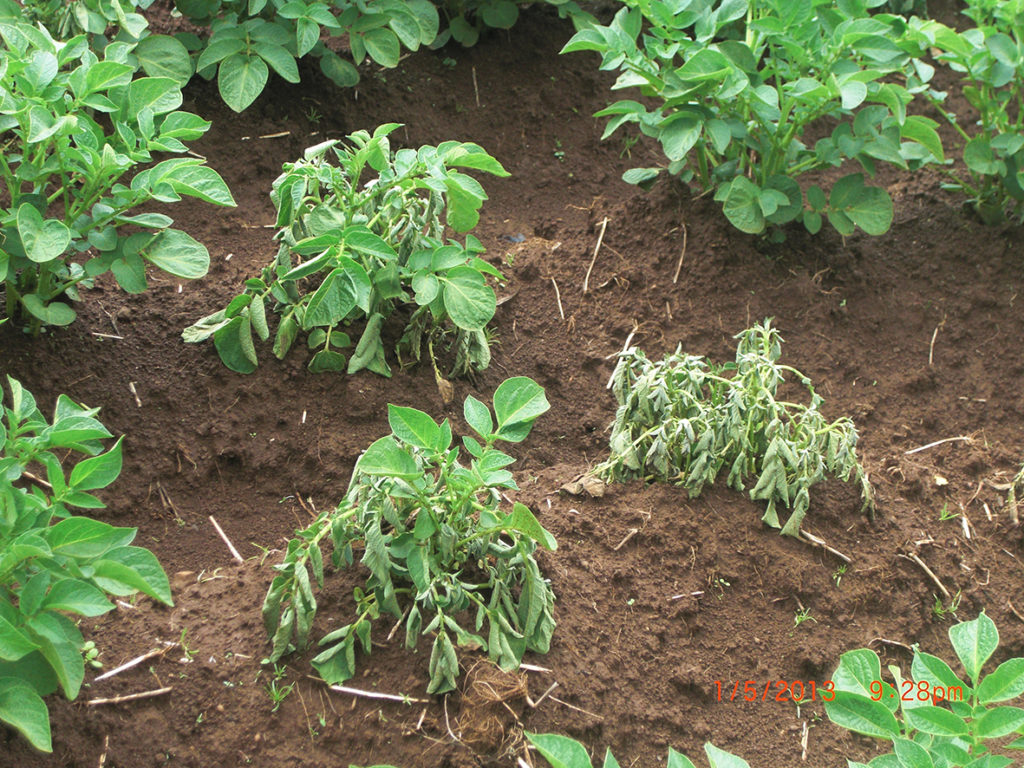Bacteria Wilt is caused by the pathogen bacterium Ralstonia Solanacearum and is quite common in the moist & humid sandy soils. This bacterium lives in the soil and will work its way quickly through the roots and up the stem of the plants. It is spread by contaminated equipment, soil, water and infected plant material.
These symptoms usually occur when the weather is hot, the humidity is high or the soil is wet. It is also common with soils that have high pH. Two to three days later, the entire plant rapidly wilts without any prior yellowing of leaves. The infected base of a stem can become discolored brown. When the infected stem cut and placed into a glass of water, it produces a milky substance from the cut end after few minutes. The milky substance is the bacteria coming out of the stem.
MONITORING AND PREVENTION
- Crop Rotation in your garden planting area
- Remove and destroy all plant refuse in the fall and use deep cultivation to bury any remaining refuse.
- Do not place diseased plants in the compost heap, as this will only serve to carry bacterial or fungal infestation into the next growing season.
- Avoid over watering. Use surface watering methods. Do not handle plants when the vines are wet.
- Weeds compete with vegetables for soil moisture and nutrients and also serve as hosts for insects and disease carrying bacteria and fungus. Control weeds in and around the garden.
- Control insect pests such as aphids, which are known to transmit diseases from plant to plant.
- Use plastic or organic mulches to reduce disease and blossom-end rot problems
- Choose a sunny location for your tomatoes. Leaf disease problems are much less likely to occur in a sunny location than in a shady one.
- Apply recommended fungicides according to label directions at the first sign of leaf spot diseases
- Remove abnormal or unhealthy appearing plants as soon as they are observed. To reduce the spread of suspected diseases wash hands and tools with a mild detergent after handling suspect plants.
COMMONLY ASKED QUESTIONS ABOUT BACTERIAL WILT
WHAT CAUSES BACTERIAL WILT IN TOMATOES?
WHAT CAUSES WILT DISEASE?
Wilt is a side effect of plant disease that is because of water misfortune in stems and leaves, and an aftereffect of microscopic organisms, parasites, and infections spreading to plants.
WHAT DOES TOMATO WILT RESEMBLE?
The main manifestations of tomato wilt show up as fruit matures, including yellowing and searing leaves, stunted leaf development, and wilting foliage. First signs are the lower leaves of the plant turning yellow. This occasionally happens just on one side of the plant, or on one side of a specific branch. Leaf and stem wilting trail yellowing.
HOW DO YOU REVIVE A WILTED TOMATO PLANT?
To restore a wilting tomato plant, water it right away. Move the tomato plant on the off chance that it is any place almost a pecan tree, as the pecan tree radiates a poison called juglone, which enters the soil and can influence encompassing plants. Prepare the soil prior to planting tomatoes and again when it begins to set fruit.
This data does not have any significant bearing to tomato plants that are wilting because of bacterial wilt. You cannot restore a plant that has been infected with bacterial wilt. The best activity when you have a tomato plant infected with bacterial wilt is to discard it right away.
HOW DO YOU FIX WILTING TOMATOES?
The most common purpose behind wilting tomatoes is dehydration. A lack of sufficient water can have a tomato plant, and its fruit wilting up in a matter of moments. Ensure you are giving your plant enough water to shield fruit from wilting. Tomatoes need at any rate two creeps of water for each week, be it given by precipitation or by manual watering.
HOW DO YOU CONTROL WILT DISEASE?
There are numerous practices you can never really control and prevent wilt disease. Plant resistant assortments when accessible. Rotate crops frequently. Eliminate any infected plants from the garden promptly upon notice. Clean and sanitize any garden apparatuses used to eliminate infected plants. Utilize a bug executioner to control garden bothers, which spread diseases that lead to wilt. In the event that issues continue, take a stab at introducing raised beds and utilizing new soil. On the other hand, you could attempt holder gardening for your tomato plants. Test and alter to carry soil to a pH range somewhere in the range of 6.2 and 6.5. Space out new plants to give every a lot of room to advance better air dissemination and solarization of your garden beds might be the appropriate response.
NB:
This bacterium survives in the soil for extended periods and enters the roots through wounds made by transplanting, cultivation or insects and through natural wounds where secondary roots emerge.
High temperatures and high moisture favor disease development. The bacteria multiply rapidly inside the water-conducting tissue of the plant, filling it with slime. This results in a rapid wilt of the plant, while the leaves stay green. If an infected stem is cut crosswise, it will look brown and tiny drops of yellowish ooze may be visible.

0 Comments